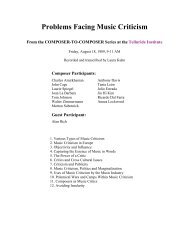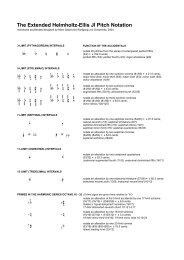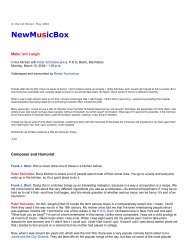Sixth World Symposium on Choral Music ... - NewMusicBox
Sixth World Symposium on Choral Music ... - NewMusicBox
Sixth World Symposium on Choral Music ... - NewMusicBox
You also want an ePaper? Increase the reach of your titles
YUMPU automatically turns print PDFs into web optimized ePapers that Google loves.
New<strong>Music</strong>Box May 2003<br />
to that note. And so you stand there like a censor or border guard, saying, "Okay you can<br />
pass…. no, you can't pass…. okay…. next!"<br />
CHEN YI: For me, usually the process goes both ways: from choosing the text and getting the<br />
image. There are many times in my life I have read a text hundreds of times, and gotten into the<br />
mood. And the most important thing is to get an image and the idea. The idea means the unique<br />
sounding, the structure, the design of the timing, and a good beginning and an impressive ending.<br />
And then the texture comes to mind. And my job is to arrange that, to write that out.<br />
R. MURRAY SCHAEFER: Well, sometimes if there is a text, the text creates the substance of<br />
the music. If there is a given text, I would take it and just sit down and maybe just scribble some<br />
features that would suggest what is going to be a lengthy vocal curve, or what is going to be very<br />
quick, rhythmic. These would be nothing more than scribbles <strong>on</strong> paper. And I'd do this maybe<br />
two or three times as I dream my way through the text, sing it to myself, and then perhaps the<br />
next day I would get a pen and start doodling some lines. I always draw my own lines. I write all<br />
scores by hand, and I find that the best way to work because it slows me down. I rule all the<br />
pentagrams myself too, so I would rule 5 lines, and then start ruling 6 and then 7, then 8, then 9,<br />
then 10 lines if I feel like it, and then I say, "Well, I guess the piece is going to have a soprano and<br />
bass part, it sort of goes from there."<br />
DALE WARLAND: How do you decide <strong>on</strong> your harm<strong>on</strong>ic language? Is it developed at the same<br />
time as the melody or is it something that happens?<br />
ERNANI AGUIAR: I do not have a special choice; no choice is made. Just a melody, the<br />
harm<strong>on</strong>y, and the counterpoint that unite the work, kind of flow together.<br />
DOMINICK ARGENTO: I d<strong>on</strong>'t think I have ever really thought about it. It just seems to be<br />
there of its own accord, no pun intended. There are some words where a certain harm<strong>on</strong>ic<br />
combinati<strong>on</strong> will be the best that I can think of to express what that word means to me or to give<br />
that word the emphasis that I want it to have. I think all of us probably have a working<br />
vocabulary of sounds that we are f<strong>on</strong>d of, and sounds that we d<strong>on</strong>'t particularly like, diss<strong>on</strong>ances<br />
or c<strong>on</strong>s<strong>on</strong>ants of all sorts. And we try to find the <strong>on</strong>es most appropriate for whatever the text<br />
happens to be. I really cannot describe it with any more clarity than that. It is something that I<br />
have never really thought about. It's as if you were to ask a centipede how it knows which foot<br />
follows the previous foot: if they had to think about it, they would become paralyzed.<br />
CHEN YI: If you c<strong>on</strong>sider all vertical sounding harm<strong>on</strong>y, then you have many kinds of harm<strong>on</strong>ic<br />
progressi<strong>on</strong>s. And sometimes I take clusters, but they are brought in <strong>on</strong>e after another in order to<br />
make it easier for the singers to join in. Sometimes if there is a row form, you have to follow the<br />
twelve-t<strong>on</strong>e rule. And if it is counterpoint writing, the vertical sounding is also a harm<strong>on</strong>ic<br />
progressi<strong>on</strong>. So I always have a combinati<strong>on</strong>. I d<strong>on</strong>’t separate them as harm<strong>on</strong>ic progressi<strong>on</strong>s<br />
strictly. My cluster may be chromatic, or it may be pentat<strong>on</strong>ic.<br />
Composers’ Dialogue #1, 08/06/2002





